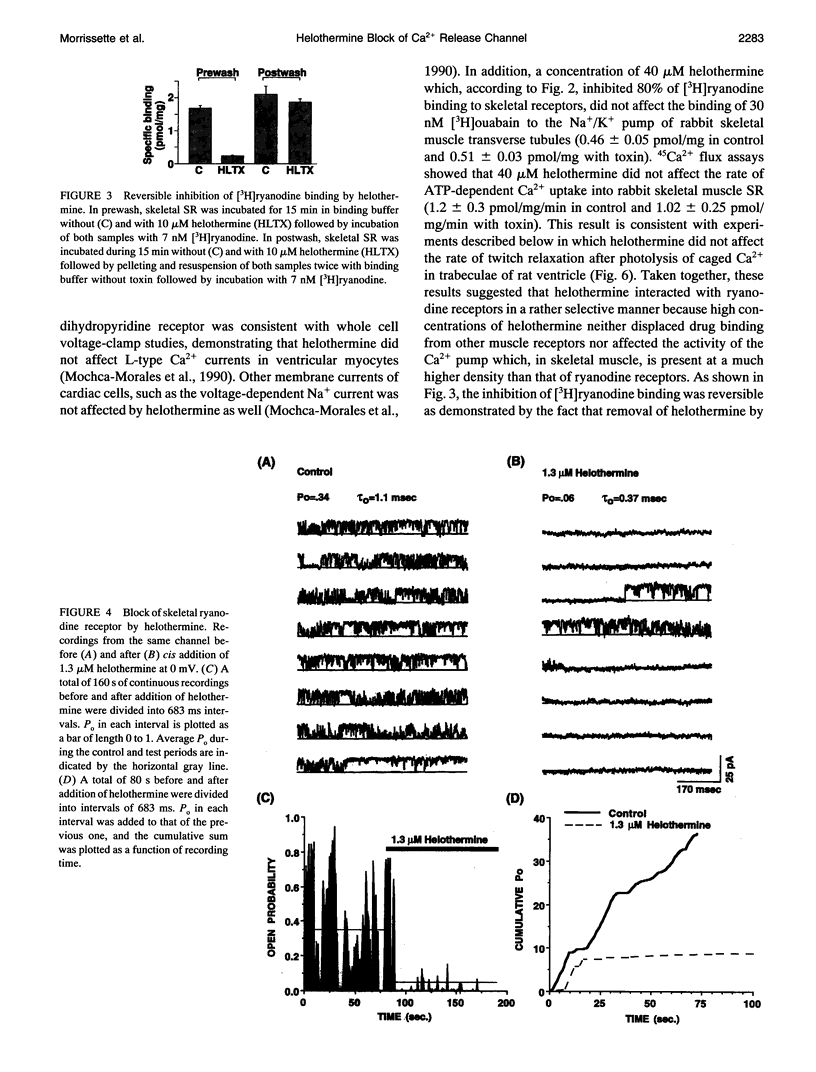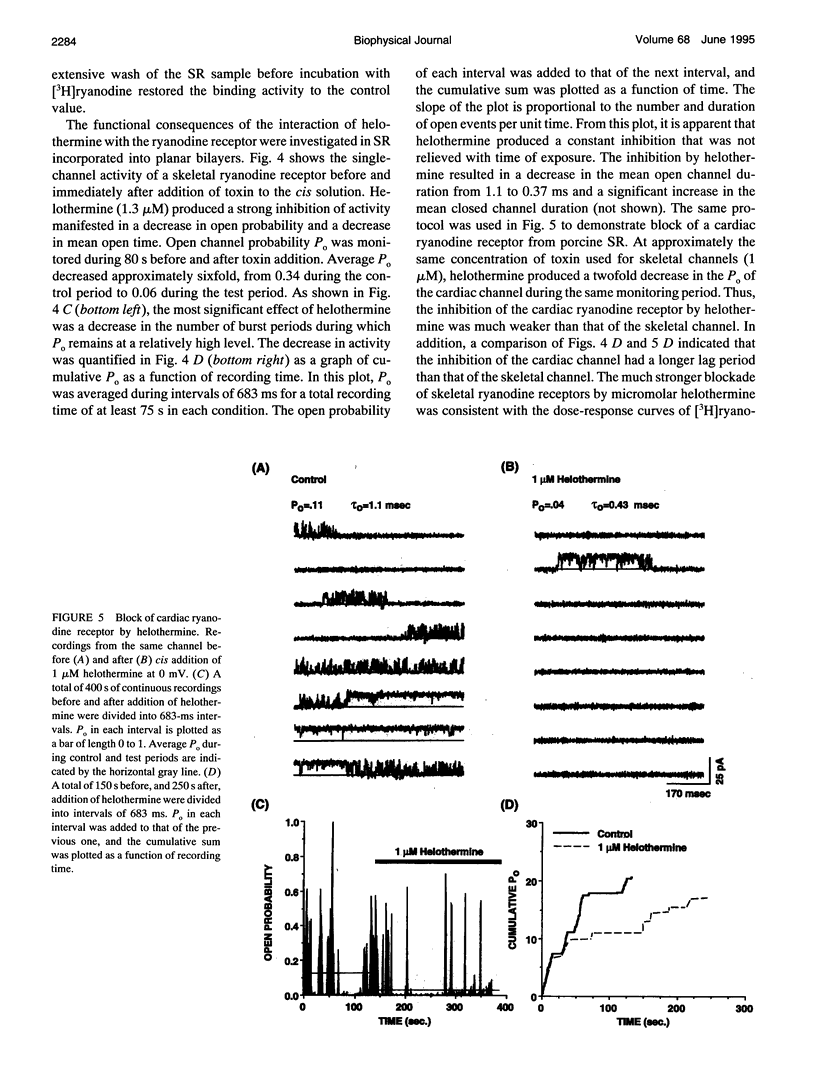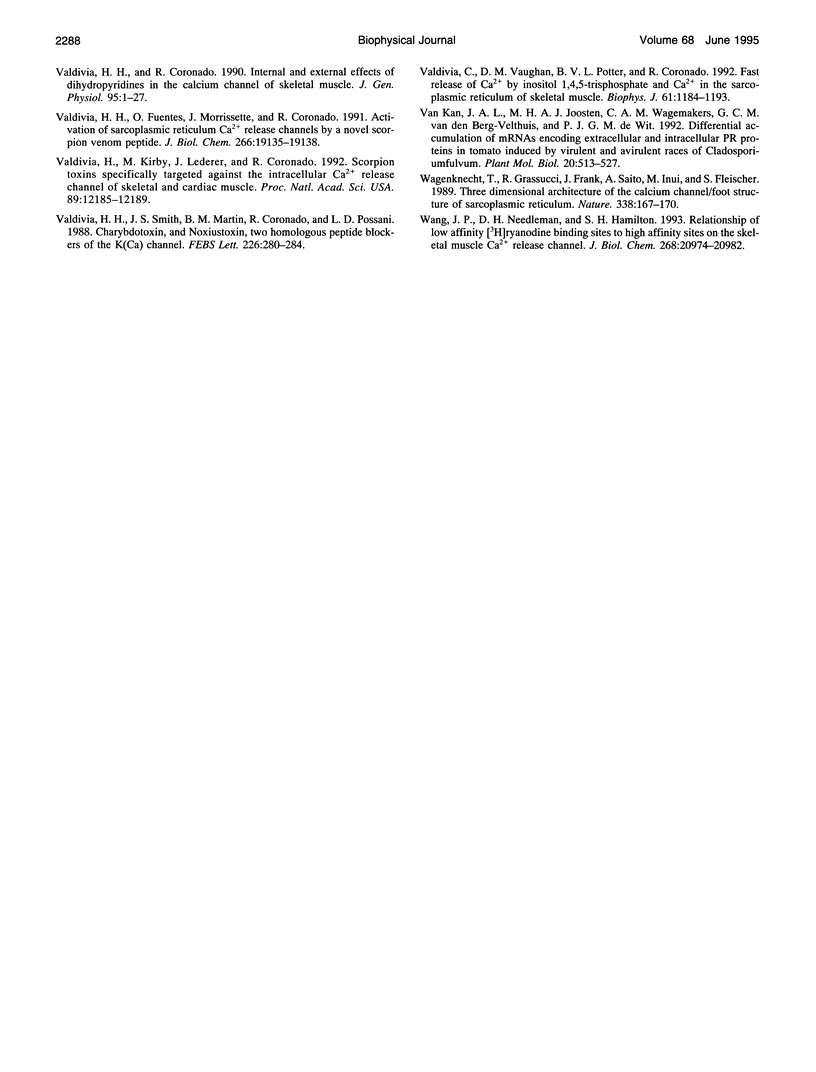Abstract
Helothermine, a protein from the venom of the Mexican beaded lizard (Heloderma horridum horridum), was found to inhibit [3H]ryanodine binding to cardiac and skeletal sarcoplasmic reticulum, to block cardiac and skeletal ryanodine receptor channels incorporated into planar bilayers, and to block Ca(2+)-induced Ca2+ release triggered by photolysis of nitr-5 in saponin-permeabilized trabeculae from rat ventricle. Cloning of the helothermine cDNA revealed that the protein is composed of 223 amino acids with a molecular mass of 25,376 daltons, and apparently is stabilized by eight disulfide bridges. The peptide sequence showed significant homology with a family of cysteine-rich secretory proteins found in the male genital tract and in salivary glands. The interaction of helothermine and ryanodine receptors should serve to define functional domains within the channel structure involved in the control of Ca2+ release from sarcoplasmic reticulum.
Full text
PDF








Images in this article
Selected References
These references are in PubMed. This may not be the complete list of references from this article.
- Alexander D., Goodman R. M., Gut-Rella M., Glascock C., Weymann K., Friedrich L., Maddox D., Ahl-Goy P., Luntz T., Ward E. Increased tolerance to two oomycete pathogens in transgenic tobacco expressing pathogenesis-related protein 1a. Proc Natl Acad Sci U S A. 1993 Aug 1;90(15):7327–7331. doi: 10.1073/pnas.90.15.7327. [DOI] [PMC free article] [PubMed] [Google Scholar]
- Brooks D. E., Means A. R., Wright E. J., Singh S. P., Tiver K. K. Molecular cloning of the cDNA for androgen-dependent sperm-coating glycoproteins secreted by the rat epididymis. Eur J Biochem. 1986 Nov 17;161(1):13–18. doi: 10.1111/j.1432-1033.1986.tb10118.x. [DOI] [PubMed] [Google Scholar]
- Callaway C., Seryshev A., Wang J. P., Slavik K. J., Needleman D. H., Cantu C., 3rd, Wu Y., Jayaraman T., Marks A. R., Hamilton S. L. Localization of the high and low affinity [3H]ryanodine binding sites on the skeletal muscle Ca2+ release channel. J Biol Chem. 1994 Jun 3;269(22):15876–15884. [PubMed] [Google Scholar]
- Casacuberta J. M., Puigdomènech P., San Segundo B. A gene coding for a basic pathogenesis-related (PR-like) protein from Zea mays. Molecular cloning and induction by a fungus (Fusarium moniliforme) in germinating maize seeds. Plant Mol Biol. 1991 Apr;16(4):527–536. doi: 10.1007/BF00023419. [DOI] [PubMed] [Google Scholar]
- Charest N. J., Joseph D. R., Wilson E. M., French F. S. Molecular cloning of complementary deoxyribonucleic acid for an androgen-regulated epididymal protein: sequence homology with metalloproteins. Mol Endocrinol. 1988 Oct;2(10):999–1004. doi: 10.1210/mend-2-10-999. [DOI] [PubMed] [Google Scholar]
- Chen S. R., Zhang L., MacLennan D. H. Characterization of a Ca2+ binding and regulatory site in the Ca2+ release channel (ryanodine receptor) of rabbit skeletal muscle sarcoplasmic reticulum. J Biol Chem. 1992 Nov 15;267(32):23318–23326. [PubMed] [Google Scholar]
- Connelly T. J., Coronado R. Activation of the Ca2+ release channel of cardiac sarcoplasmic reticulum by volatile anesthetics. Anesthesiology. 1994 Aug;81(2):459–469. doi: 10.1097/00000542-199408000-00025. [DOI] [PubMed] [Google Scholar]
- Cornelissen B. J., Horowitz J., van Kan J. A., Goldberg R. B., Bol J. F. Structure of tobacco genes encoding pathogenesis-related proteins from the PR-1 group. Nucleic Acids Res. 1987 Sep 11;15(17):6799–6811. doi: 10.1093/nar/15.17.6799. [DOI] [PMC free article] [PubMed] [Google Scholar]
- Coronado R., Kawano S., Lee C. J., Valdivia C., Valdivia H. H. Planar bilayer recording of ryanodine receptors of sarcoplasmic reticulum. Methods Enzymol. 1992;207:699–707. doi: 10.1016/0076-6879(92)07051-o. [DOI] [PubMed] [Google Scholar]
- Coronado R., Morrissette J., Sukhareva M., Vaughan D. M. Structure and function of ryanodine receptors. Am J Physiol. 1994 Jun;266(6 Pt 1):C1485–C1504. doi: 10.1152/ajpcell.1994.266.6.C1485. [DOI] [PubMed] [Google Scholar]
- Devereux J., Haeberli P., Smithies O. A comprehensive set of sequence analysis programs for the VAX. Nucleic Acids Res. 1984 Jan 11;12(1 Pt 1):387–395. doi: 10.1093/nar/12.1part1.387. [DOI] [PMC free article] [PubMed] [Google Scholar]
- Endoh M., Blinks J. R. Actions of sympathomimetic amines on the Ca2+ transients and contractions of rabbit myocardium: reciprocal changes in myofibrillar responsiveness to Ca2+ mediated through alpha- and beta-adrenoceptors. Circ Res. 1988 Feb;62(2):247–265. doi: 10.1161/01.res.62.2.247. [DOI] [PubMed] [Google Scholar]
- Fang K. S., Vitale M., Fehlner P., King T. P. cDNA cloning and primary structure of a white-face hornet venom allergen, antigen 5. Proc Natl Acad Sci U S A. 1988 Feb;85(3):895–899. doi: 10.1073/pnas.85.3.895. [DOI] [PMC free article] [PubMed] [Google Scholar]
- Giangiacomo K. M., Sugg E. E., Garcia-Calvo M., Leonard R. J., McManus O. B., Kaczorowski G. J., Garcia M. L. Synthetic charybdotoxin-iberiotoxin chimeric peptides define toxin binding sites on calcium-activated and voltage-dependent potassium channels. Biochemistry. 1993 Mar 9;32(9):2363–2370. doi: 10.1021/bi00060a030. [DOI] [PubMed] [Google Scholar]
- Haendler B., Krätzschmar J., Theuring F., Schleuning W. D. Transcripts for cysteine-rich secretory protein-1 (CRISP-1; DE/AEG) and the novel related CRISP-3 are expressed under androgen control in the mouse salivary gland. Endocrinology. 1993 Jul;133(1):192–198. doi: 10.1210/endo.133.1.8319566. [DOI] [PubMed] [Google Scholar]
- Hoffman D. R. Allergens in Hymenoptera venom XXIV: the amino acid sequences of imported fire ant venom allergens Sol i II, Sol i III, and Sol i IV. J Allergy Clin Immunol. 1993 Jan;91(1 Pt 1):71–78. doi: 10.1016/0091-6749(93)90298-t. [DOI] [PubMed] [Google Scholar]
- Hoffman D. R. Allergens in Hymenoptera venom. XXV: The amino acid sequences of antigen 5 molecules and the structural basis of antigenic cross-reactivity. J Allergy Clin Immunol. 1993 Nov;92(5):707–716. doi: 10.1016/0091-6749(93)90014-7. [DOI] [PubMed] [Google Scholar]
- Kasahara M., Gutknecht J., Brew K., Spurr N., Goodfellow P. N. Cloning and mapping of a testis-specific gene with sequence similarity to a sperm-coating glycoprotein gene. Genomics. 1989 Oct;5(3):527–534. doi: 10.1016/0888-7543(89)90019-0. [DOI] [PubMed] [Google Scholar]
- Lu G., Villalba M., Coscia M. R., Hoffman D. R., King T. P. Sequence analysis and antigenic cross-reactivity of a venom allergen, antigen 5, from hornets, wasps, and yellow jackets. J Immunol. 1993 Apr 1;150(7):2823–2830. [PubMed] [Google Scholar]
- MacKinnon R., Miller C. Mutant potassium channels with altered binding of charybdotoxin, a pore-blocking peptide inhibitor. Science. 1989 Sep 22;245(4924):1382–1385. doi: 10.1126/science.2476850. [DOI] [PubMed] [Google Scholar]
- Martin B. M., Carbone E., Yatani A., Brown A. M., Ramírez A. N., Gurrola G. B., Possani L. D. Amino acid sequence and physiological characterization of toxins from the venom of the scorpion Centruroides limpidus tecomanus Hoffmann. Toxicon. 1988;26(9):785–794. doi: 10.1016/0041-0101(88)90319-4. [DOI] [PubMed] [Google Scholar]
- McPherson P. S., Campbell K. P. The ryanodine receptor/Ca2+ release channel. J Biol Chem. 1993 Jul 5;268(19):13765–13768. [PubMed] [Google Scholar]
- Mizuki N., Kasahara M. Mouse submandibular glands express an androgen-regulated transcript encoding an acidic epididymal glycoprotein-like molecule. Mol Cell Endocrinol. 1992 Nov;89(1-2):25–32. doi: 10.1016/0303-7207(92)90207-m. [DOI] [PubMed] [Google Scholar]
- Mizuki N., Sarapata D. E., Garcia-Sanz J. A., Kasahara M. The mouse male germ cell-specific gene Tpx-1: molecular structure, mode of expression in spermatogenesis, and sequence similarity to two non-mammalian genes. Mamm Genome. 1992;3(5):274–280. doi: 10.1007/BF00292155. [DOI] [PubMed] [Google Scholar]
- Mochca-Morales J., Martin B. M., Possani L. D. Isolation and characterization of helothermine, a novel toxin from Heloderma horridum horridum (Mexican beaded lizard) venom. Toxicon. 1990;28(3):299–309. doi: 10.1016/0041-0101(90)90065-f. [DOI] [PubMed] [Google Scholar]
- Muradov A., Petrasovits L., Davidson A., Scott K. J. A cDNA clone for a pathogenesis-related protein 1 from barley. Plant Mol Biol. 1993 Oct;23(2):439–442. doi: 10.1007/BF00029021. [DOI] [PubMed] [Google Scholar]
- Otsu K., Willard H. F., Khanna V. K., Zorzato F., Green N. M., MacLennan D. H. Molecular cloning of cDNA encoding the Ca2+ release channel (ryanodine receptor) of rabbit cardiac muscle sarcoplasmic reticulum. J Biol Chem. 1990 Aug 15;265(23):13472–13483. [PubMed] [Google Scholar]
- Possani L. D., Martin B. M., Svendsen I., Rode G. S., Erickson B. W. Scorpion toxins from Centruroides noxius and Tityus serrulatus. Primary structures and sequence comparison by metric analysis. Biochem J. 1985 Aug 1;229(3):739–750. doi: 10.1042/bj2290739. [DOI] [PMC free article] [PubMed] [Google Scholar]
- Possani L. D., Martin B. M., Yatani A., Mochca-Morales J., Zamudio F. Z., Gurrola G. B., Brown A. M. Isolation and physiological characterization of taicatoxin, a complex toxin with specific effects on calcium channels. Toxicon. 1992 Nov;30(11):1343–1364. doi: 10.1016/0041-0101(92)90511-3. [DOI] [PubMed] [Google Scholar]
- Sanger F., Nicklen S., Coulson A. R. DNA sequencing with chain-terminating inhibitors. Proc Natl Acad Sci U S A. 1977 Dec;74(12):5463–5467. doi: 10.1073/pnas.74.12.5463. [DOI] [PMC free article] [PubMed] [Google Scholar]
- Schuren F. H., Asgeirsdóttir S. A., Kothe E. M., Scheer J. M., Wessels J. G. The Sc7/Sc14 gene family of Schizophyllum commune codes for extracellular proteins specifically expressed during fruit-body formation. J Gen Microbiol. 1993 Sep;139(9):2083–2090. doi: 10.1099/00221287-139-9-2083. [DOI] [PubMed] [Google Scholar]
- Sorrentino V., Volpe P. Ryanodine receptors: how many, where and why? Trends Pharmacol Sci. 1993 Mar;14(3):98–103. doi: 10.1016/0165-6147(93)90072-r. [DOI] [PubMed] [Google Scholar]
- Sosa B. P., Alagón A. C., Martin B. M., Possani L. D. Biochemical characterization of the phospholipase A2 purified from the venom of the Mexican beaded lizard (Heloderma horridum horridum Wiegmann). Biochemistry. 1986 May 20;25(10):2927–2933. doi: 10.1021/bi00358a029. [DOI] [PubMed] [Google Scholar]
- Uknes S., Mauch-Mani B., Moyer M., Potter S., Williams S., Dincher S., Chandler D., Slusarenko A., Ward E., Ryals J. Acquired resistance in Arabidopsis. Plant Cell. 1992 Jun;4(6):645–656. doi: 10.1105/tpc.4.6.645. [DOI] [PMC free article] [PubMed] [Google Scholar]
- Valdivia C., Vaughan D., Potter B. V., Coronado R. Fast release of 45Ca2+ induced by inositol 1,4,5-trisphosphate and Ca2+ in the sarcoplasmic reticulum of rabbit skeletal muscle: evidence for two types of Ca2+ release channels. Biophys J. 1992 May;61(5):1184–1193. doi: 10.1016/S0006-3495(92)81927-6. [DOI] [PMC free article] [PubMed] [Google Scholar]
- Valdivia H. H., Coronado R. Internal and external effects of dihydropyridines in the calcium channel of skeletal muscle. J Gen Physiol. 1990 Jan;95(1):1–27. doi: 10.1085/jgp.95.1.1. [DOI] [PMC free article] [PubMed] [Google Scholar]
- Valdivia H. H., Fuentes O., el-Hayek R., Morrissette J., Coronado R. Activation of the ryanodine receptor Ca2+ release channel of sarcoplasmic reticulum by a novel scorpion venom. J Biol Chem. 1991 Oct 15;266(29):19135–19138. [PubMed] [Google Scholar]
- Valdivia H. H., Kirby M. S., Lederer W. J., Coronado R. Scorpion toxins targeted against the sarcoplasmic reticulum Ca(2+)-release channel of skeletal and cardiac muscle. Proc Natl Acad Sci U S A. 1992 Dec 15;89(24):12185–12189. doi: 10.1073/pnas.89.24.12185. [DOI] [PMC free article] [PubMed] [Google Scholar]
- Valdivia H. H., Smith J. S., Martin B. M., Coronado R., Possani L. D. Charybdotoxin and noxiustoxin, two homologous peptide inhibitors of the K+ (Ca2+) channel. FEBS Lett. 1988 Jan 4;226(2):280–284. doi: 10.1016/0014-5793(88)81439-x. [DOI] [PubMed] [Google Scholar]
- Wagenknecht T., Grassucci R., Frank J., Saito A., Inui M., Fleischer S. Three-dimensional architecture of the calcium channel/foot structure of sarcoplasmic reticulum. Nature. 1989 Mar 9;338(6211):167–170. doi: 10.1038/338167a0. [DOI] [PubMed] [Google Scholar]
- Wang J. P., Needleman D. H., Hamilton S. L. Relationship of low affinity [3]ryanodine binding sites to high affinity sites on the skeletal muscle Ca2+ release channel. J Biol Chem. 1993 Oct 5;268(28):20974–20982. [PubMed] [Google Scholar]
- van Kan J. A., Joosten M. H., Wagemakers C. A., van den Berg-Velthuis G. C., de Wit P. J. Differential accumulation of mRNAs encoding extracellular and intracellular PR proteins in tomato induced by virulent and avirulent races of Cladosporium fulvum. Plant Mol Biol. 1992 Nov;20(3):513–527. doi: 10.1007/BF00040610. [DOI] [PubMed] [Google Scholar]



